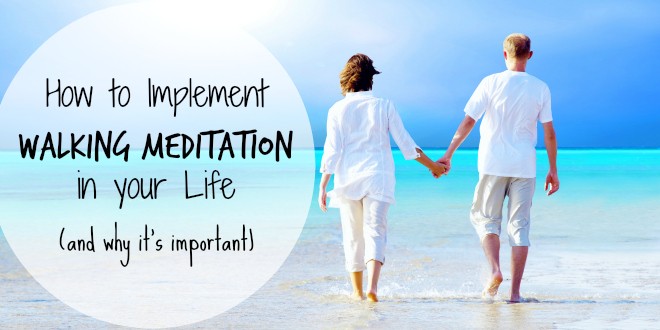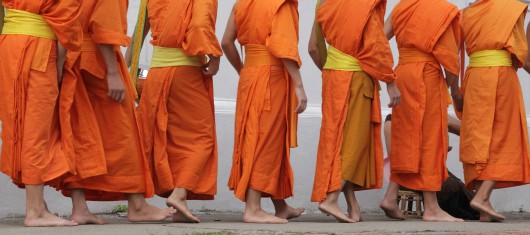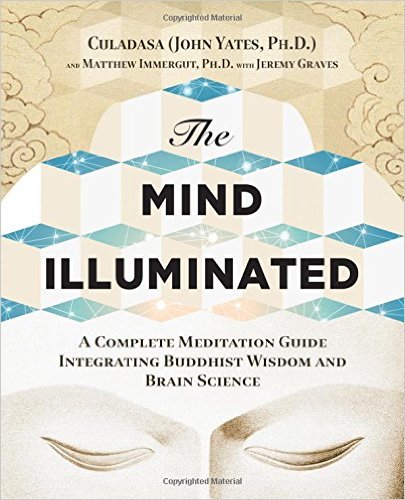How to Implement Walking Meditation in your Life (and why it's important)

[box type="note" align="aligncenter" class="" width=""]A note from Coach Moose: Walking Meditation is perfect for those new to the concepts of mindfulness or meditation, or for those that meditate and want to add to their seated practice, and especially anyone who simply wants to enjoy nature in a mindful way. The following guest post is written by Culadasa John Yates Ph. D's new book, The Mind Illuminated: A Complete Meditation Guide Integrating Buddhist Wisdom and Brain Science.
https://www.youtube.com/watch?v=UVvBI0s2Cww
[/box]
Walking Meditation is both a powerful practice in its own right and an indispensable complement to sitting practice. Too often it’s not taken seriously enough; we imagine a meditator to be someone who only sits cross-legged with eyes closed. But walking meditation is just as effective as sitting for developing stable attention and powerful mindfulness. It’s even more effective for some things. The best way to make rapid progress is to combine the two.
[caption id="attachment_20267" align="aligncenter" width="530"] Monks walking in Lao[/caption]
Monks walking in Lao[/caption]
The practices of walking and sitting meditation are essentially the same: stabilize your attention while sustaining or even increasing peripheral awareness. The only real difference is where you focus your attention. Here, you fix it on the sensations in the soles of your feet, rather than on the breath at the nose. Alternatively, you can use the sensations in the muscles, joints, and tendons of your legs as the meditation object. Walking, like breathing, is an automatic activity, and the ever changing sensations with each step provide a continuous anchor for attention. At the same time, peripheral awareness stays open to whatever is happening in the internal and external world. Walking meditation offers a variety of opportunities for working with attention and peripheral awareness in different ways.
As a part of your daily practice, you can do walking meditation first to help calm your mind in preparation for sitting. Or you can walk right after sitting, which brings a high level of focused attention to the walking practice. You can also do walking meditation separately from sitting whenever it’s convenient. During meditation retreats, or on days set aside for more extensive practice, alternate walking and sitting practices. This gives your body a chance to limber up and recover from the effects of long periods of motionless sitting, but without interrupting your practice. Never treat walking meditation as a “break” from your practice. If you really do need to take a break, do something completely different, like going for a stroll or taking a nap.
[caption id="attachment_20270" align="aligncenter" width="530"] Can you see yourself walking here?[/caption]
Can you see yourself walking here?[/caption]
The best location for walking meditation practice is outdoors. An open space where you won’t be interrupted, such as a back yard, gardens, or park is perfect. A place with some sort of natural beauty is ideal, but not essential, since aesthetic enjoyment isn’t the main point. A quiet city sidewalk also works quite well. Use a path you can follow easily, so you don’t need to make decisions about where to go as you walk. Otherwise, just plan your path in advance and make adjustments as needed. Of course, you can also walk indoors. Choose a large room or a hallway that allows you to go about 20 feet or so before you have to turn around. You can also just walk a circular path in a smaller room.
Begin doing the walking practice for 15 to 30 minutes at a time. In general, you will likely find that 30 minutes is a good period. As you get into the practice, you may find you want to walk for an hour or more at a time. Walking meditation is easy and relaxing, so the biggest constraint on how long you walk each day is simply time and opportunity.
[caption id="attachment_20268" align="aligncenter" width="530"] Be present in the moment... enjoy it.[/caption]
Be present in the moment... enjoy it.[/caption]
Each technique used in walking meditation builds on the skills you’ve already developed in your sitting practice. Since the skills being developed in walking meditation are the same as with your sitting practice, the progression of walking techniques is described in the same sequence. This is helpful for organizing a discussion such as this, but there’s actually a lot of latitude for customizing these practices according to your own experience. Still, no matter which technique you happen to use, always remember to keep an attitude of interest, exploration, relaxation, and enjoyment. The more meditation becomes associated with feelings of happiness and pleasure, the stronger your motivation and the faster your progress.
Stage One walking meditation is simple and relaxed, and quite like the Four Step Transition described for Stage One sitting meditation. To begin with, as in Step One of the transition, it’s all about exploring the present moment. You allow your attention to move freely while keeping your awareness open as you walk. The only restriction is to stay fully in the present, the here and now. By the end of this Stage, however, your attention will be continuously focused on the sensations of walking, just like with Step Four of the transition to the breath.
Before you even begin the formal walking practice, you first need to experiment with various walking speeds while carefully observing their differences. Begin by walking at a normal, unhurried pace. Notice how automatic the process is, barely needing any attention at all. The mind is free to go where it will. At first, you’ll notice all sorts of things in your surroundings, but you’ll quickly find yourself caught up in thoughts and memories that take you away from the present. When you catch your mind wandering, simply bring yourself back to the present by focusing your attention on the sensations in your feet. For the next few steps, keep your attention on your feet to help you stay in the here and now. Notice how similar this is to sitting meditation: you can be aware of everything around you—sights, sounds, and other sensations—while keeping your attention on your feet. Now release your attention from the feet, allowing it to continue exploring the present as you walk at a normal pace.
[caption id="attachment_20269" align="aligncenter" width="530"] Explore your wilderness... wherever your feet may take you.[/caption]
Explore your wilderness... wherever your feet may take you.[/caption]
Next, speed up as if you were in a hurry to get somewhere. Notice how at first you need to pay more attention than before to direction, obstacles, and footing, but then peripheral awareness quickly takes over that job. Once that happens, you’ll soon find yourself thinking of things totally unrelated to where you are and what you are doing, and may even forget that you’re supposed to be meditating. It’s much more difficult to keep yourself in the present by attending to the sensations in your feet: they’re just too brief and changing to serve as an effective anchor. The full activity of walking, however—arms swinging, legs moving, torso pivoting, etc.—works far better as an anchor for attention when walking quickly. You don’t need to spend much time doing fast-walking meditation, just enough to learn the different effects it has on the way attention and awareness work together, and on your ability to stay in the present.
Finally, try walking very, very slowly, as if you were trying to sneak around. Notice the loss of fluid movement, and how almost every detail of the process needs attention and deliberate control. Note especially how walking very slowly not only helps keep you in the present, but also naturally causes attention to go to the feet; when your attention strays for even a few moments, wobbling, instability, and loss of balance quickly bring you back to the here and now.
Again, you’re just experimenting to familiarize yourself with the effects speed has on attention, awareness, and your ability to stay in the present. This will be very useful information to have at different Stages of walking practice, allowing you to adjust your speed for different purposes. Most will find one or two sessions of experimenting with different speeds is enough, but feel free to continue as long as you’re still learning from it.
[caption id="attachment_20272" align="alignleft" width="425"] Photo Credit: https://www.ligminchalearning.com/integrating-real-life-issues-into-meditation-practice
[/caption]
Photo Credit: https://www.ligminchalearning.com/integrating-real-life-issues-into-meditation-practice
[/caption]
To begin your formal practice, choose a comfortable pace, one that is slow enough to easily observe changing sensations in the soles of your feet, but fast enough to be mostly automatic—what might be called “slow normal.” Spend more and more time attending to the sensations in your feet as you walk. They will eventually become your primary meditation object, but don’t restrict your attention to them just yet. For now, your primary objective is just to remain in the present as you walk. This means your attention can move from your feet to anything happening in the moment that you find interesting. However, these must always be intentional movements of attention! If you are out-side, there will be sounds, interesting and attractive visual objects, and odors. Intentionally allow the mind to observe and explore them. Feel the warmth of sunlight, the coolness of shade, and the breeze touching your face. Investigate and engage fully with these things, taking it all in. Whenever an object of attention goes away or ceases to be interesting, return to the sensations in your feet.
Again, always stay in the present. Explore and fully experience your surroundings with both attention and awareness, but don’t get lost in thinking, which takes you away from the present. Whenever you realize thinking has carried you away, bring your attention back to the sensations in your feet or legs to keep those thoughts at bay. As the novelty of slow walking wears off, thoughts become more frequent, and you’ll need to anchor attention to your feet more often. This is completely normal. You’ll eventually be keeping the focus of your attention more or less continuously on the sensations of walking.
In the course of learning to keep attention from getting captured, you’ll also discover how to observe thoughts in peripheral awareness. When you realize you’ve been thinking or remembering, return to the present by focusing your attention on walking, but let the thought or memory continue to unfold in the background of peripheral awareness. When attention is engaged in thinking or remembering, you’re not in the present. But having peripheral awareness of thoughts or memories is all right, because it’s the same as having peripheral awareness of sights, sounds, or sensations. When you know that you’re remembering something, in the sense that you’re aware of a m
[caption id="attachment_20271" align="alignright" width="330"] For more on meditation techniques and how to's, this is the book to buy.[/caption]
For more on meditation techniques and how to's, this is the book to buy.[/caption]
emory coming up in the background, that’s actually part of present-moment awareness. Likewise, being aware that discursive thoughts are coming up in the background, or even being aware that you had been engaged with those thoughts just a moment before, is part of being fully present. With practice, you can observe the activities of thinking or remembering, letting them continue in the background, then letting them go on their own— all without ever leaving the present.
Simply staying in the present while walking cultivates all the same mental faculties as sitting and attending to the breath. You are intentionally directing attention, either to objects of interest that present themselves, or to the sensations in your feet. You’re also continuously exercising peripheral awareness by being open to everything in your surroundings. Whenever you realize attention has slipped away from the present moment, you’re exercising introspective awareness as well. And by intentionally using directed and sustained attention in conjunction with peripheral awareness, you are practicing mindfulness while walking.
The walking meditation just described should feel pleasant, relaxing, and easy. Sitting practice can easily become too goal-oriented and intense, so the relaxed quality of walking provides a valuable antidote to excessive striving, keeping your practice in balance. Remember, feelings of pleasure and happiness are essential for sustaining motivation over the long term. Therefore, the best way to support and reinforce your sitting practice is to combine it with at least half an hour of walking meditation per day.
[divider style="dashed" top="15" bottom="15"]
 Culadasa (JOHN YATES, Ph.D.) is a meditation master with over four decades of experience in the Tibetan and Theravada Buddhist traditions. A former professor, he taught physiology and neuroscience for many years, and later worked in the field of complementary and alternative medicine. He is the author of A Physician's Guide to Therapeutic Massage, currently in its third edition.
Culadasa (JOHN YATES, Ph.D.) is a meditation master with over four decades of experience in the Tibetan and Theravada Buddhist traditions. A former professor, he taught physiology and neuroscience for many years, and later worked in the field of complementary and alternative medicine. He is the author of A Physician's Guide to Therapeutic Massage, currently in its third edition.
Be sure to connect with Dr. Culadasa John Yates at the following:
www.Culadasa.com
Facebook.com/Culadasa.John.Yates and
Twitter @Culadasa
https://www.youtube.com/watch?v=UVvBI0s2Cww
[/box]
What is Walking Meditation and Why Should I use it in My Life?
Walking Meditation is both a powerful practice in its own right and an indispensable complement to sitting practice. Too often it’s not taken seriously enough; we imagine a meditator to be someone who only sits cross-legged with eyes closed. But walking meditation is just as effective as sitting for developing stable attention and powerful mindfulness. It’s even more effective for some things. The best way to make rapid progress is to combine the two.
[caption id="attachment_20267" align="aligncenter" width="530"]
 Monks walking in Lao[/caption]
Monks walking in Lao[/caption]The practices of walking and sitting meditation are essentially the same: stabilize your attention while sustaining or even increasing peripheral awareness. The only real difference is where you focus your attention. Here, you fix it on the sensations in the soles of your feet, rather than on the breath at the nose. Alternatively, you can use the sensations in the muscles, joints, and tendons of your legs as the meditation object. Walking, like breathing, is an automatic activity, and the ever changing sensations with each step provide a continuous anchor for attention. At the same time, peripheral awareness stays open to whatever is happening in the internal and external world. Walking meditation offers a variety of opportunities for working with attention and peripheral awareness in different ways.
As a part of your daily practice, you can do walking meditation first to help calm your mind in preparation for sitting. Or you can walk right after sitting, which brings a high level of focused attention to the walking practice. You can also do walking meditation separately from sitting whenever it’s convenient. During meditation retreats, or on days set aside for more extensive practice, alternate walking and sitting practices. This gives your body a chance to limber up and recover from the effects of long periods of motionless sitting, but without interrupting your practice. Never treat walking meditation as a “break” from your practice. If you really do need to take a break, do something completely different, like going for a stroll or taking a nap.
Where should I walk when practicing Walking Mediation?
[caption id="attachment_20270" align="aligncenter" width="530"]
 Can you see yourself walking here?[/caption]
Can you see yourself walking here?[/caption]The best location for walking meditation practice is outdoors. An open space where you won’t be interrupted, such as a back yard, gardens, or park is perfect. A place with some sort of natural beauty is ideal, but not essential, since aesthetic enjoyment isn’t the main point. A quiet city sidewalk also works quite well. Use a path you can follow easily, so you don’t need to make decisions about where to go as you walk. Otherwise, just plan your path in advance and make adjustments as needed. Of course, you can also walk indoors. Choose a large room or a hallway that allows you to go about 20 feet or so before you have to turn around. You can also just walk a circular path in a smaller room.
How long should I walk when practicing Walking Meditation?
Begin doing the walking practice for 15 to 30 minutes at a time. In general, you will likely find that 30 minutes is a good period. As you get into the practice, you may find you want to walk for an hour or more at a time. Walking meditation is easy and relaxing, so the biggest constraint on how long you walk each day is simply time and opportunity.
Walking through the stages (of Walking Meditation)
[caption id="attachment_20268" align="aligncenter" width="530"]
 Be present in the moment... enjoy it.[/caption]
Be present in the moment... enjoy it.[/caption]Each technique used in walking meditation builds on the skills you’ve already developed in your sitting practice. Since the skills being developed in walking meditation are the same as with your sitting practice, the progression of walking techniques is described in the same sequence. This is helpful for organizing a discussion such as this, but there’s actually a lot of latitude for customizing these practices according to your own experience. Still, no matter which technique you happen to use, always remember to keep an attitude of interest, exploration, relaxation, and enjoyment. The more meditation becomes associated with feelings of happiness and pleasure, the stronger your motivation and the faster your progress.
Stage One: Staying in the Present
Stage One walking meditation is simple and relaxed, and quite like the Four Step Transition described for Stage One sitting meditation. To begin with, as in Step One of the transition, it’s all about exploring the present moment. You allow your attention to move freely while keeping your awareness open as you walk. The only restriction is to stay fully in the present, the here and now. By the end of this Stage, however, your attention will be continuously focused on the sensations of walking, just like with Step Four of the transition to the breath.
Walking Meditation: Exploring Walking
Before you even begin the formal walking practice, you first need to experiment with various walking speeds while carefully observing their differences. Begin by walking at a normal, unhurried pace. Notice how automatic the process is, barely needing any attention at all. The mind is free to go where it will. At first, you’ll notice all sorts of things in your surroundings, but you’ll quickly find yourself caught up in thoughts and memories that take you away from the present. When you catch your mind wandering, simply bring yourself back to the present by focusing your attention on the sensations in your feet. For the next few steps, keep your attention on your feet to help you stay in the here and now. Notice how similar this is to sitting meditation: you can be aware of everything around you—sights, sounds, and other sensations—while keeping your attention on your feet. Now release your attention from the feet, allowing it to continue exploring the present as you walk at a normal pace.
[caption id="attachment_20269" align="aligncenter" width="530"]
 Explore your wilderness... wherever your feet may take you.[/caption]
Explore your wilderness... wherever your feet may take you.[/caption]Next, speed up as if you were in a hurry to get somewhere. Notice how at first you need to pay more attention than before to direction, obstacles, and footing, but then peripheral awareness quickly takes over that job. Once that happens, you’ll soon find yourself thinking of things totally unrelated to where you are and what you are doing, and may even forget that you’re supposed to be meditating. It’s much more difficult to keep yourself in the present by attending to the sensations in your feet: they’re just too brief and changing to serve as an effective anchor. The full activity of walking, however—arms swinging, legs moving, torso pivoting, etc.—works far better as an anchor for attention when walking quickly. You don’t need to spend much time doing fast-walking meditation, just enough to learn the different effects it has on the way attention and awareness work together, and on your ability to stay in the present.
Finally, try walking very, very slowly, as if you were trying to sneak around. Notice the loss of fluid movement, and how almost every detail of the process needs attention and deliberate control. Note especially how walking very slowly not only helps keep you in the present, but also naturally causes attention to go to the feet; when your attention strays for even a few moments, wobbling, instability, and loss of balance quickly bring you back to the here and now.
Again, you’re just experimenting to familiarize yourself with the effects speed has on attention, awareness, and your ability to stay in the present. This will be very useful information to have at different Stages of walking practice, allowing you to adjust your speed for different purposes. Most will find one or two sessions of experimenting with different speeds is enough, but feel free to continue as long as you’re still learning from it.
Walking Meditation : The Practice
[caption id="attachment_20272" align="alignleft" width="425"]
 Photo Credit: https://www.ligminchalearning.com/integrating-real-life-issues-into-meditation-practice
[/caption]
Photo Credit: https://www.ligminchalearning.com/integrating-real-life-issues-into-meditation-practice
[/caption]To begin your formal practice, choose a comfortable pace, one that is slow enough to easily observe changing sensations in the soles of your feet, but fast enough to be mostly automatic—what might be called “slow normal.” Spend more and more time attending to the sensations in your feet as you walk. They will eventually become your primary meditation object, but don’t restrict your attention to them just yet. For now, your primary objective is just to remain in the present as you walk. This means your attention can move from your feet to anything happening in the moment that you find interesting. However, these must always be intentional movements of attention! If you are out-side, there will be sounds, interesting and attractive visual objects, and odors. Intentionally allow the mind to observe and explore them. Feel the warmth of sunlight, the coolness of shade, and the breeze touching your face. Investigate and engage fully with these things, taking it all in. Whenever an object of attention goes away or ceases to be interesting, return to the sensations in your feet.
Again, always stay in the present. Explore and fully experience your surroundings with both attention and awareness, but don’t get lost in thinking, which takes you away from the present. Whenever you realize thinking has carried you away, bring your attention back to the sensations in your feet or legs to keep those thoughts at bay. As the novelty of slow walking wears off, thoughts become more frequent, and you’ll need to anchor attention to your feet more often. This is completely normal. You’ll eventually be keeping the focus of your attention more or less continuously on the sensations of walking.
In the course of learning to keep attention from getting captured, you’ll also discover how to observe thoughts in peripheral awareness. When you realize you’ve been thinking or remembering, return to the present by focusing your attention on walking, but let the thought or memory continue to unfold in the background of peripheral awareness. When attention is engaged in thinking or remembering, you’re not in the present. But having peripheral awareness of thoughts or memories is all right, because it’s the same as having peripheral awareness of sights, sounds, or sensations. When you know that you’re remembering something, in the sense that you’re aware of a m
[caption id="attachment_20271" align="alignright" width="330"]
 For more on meditation techniques and how to's, this is the book to buy.[/caption]
For more on meditation techniques and how to's, this is the book to buy.[/caption]emory coming up in the background, that’s actually part of present-moment awareness. Likewise, being aware that discursive thoughts are coming up in the background, or even being aware that you had been engaged with those thoughts just a moment before, is part of being fully present. With practice, you can observe the activities of thinking or remembering, letting them continue in the background, then letting them go on their own— all without ever leaving the present.
Simply staying in the present while walking cultivates all the same mental faculties as sitting and attending to the breath. You are intentionally directing attention, either to objects of interest that present themselves, or to the sensations in your feet. You’re also continuously exercising peripheral awareness by being open to everything in your surroundings. Whenever you realize attention has slipped away from the present moment, you’re exercising introspective awareness as well. And by intentionally using directed and sustained attention in conjunction with peripheral awareness, you are practicing mindfulness while walking.
The walking meditation just described should feel pleasant, relaxing, and easy. Sitting practice can easily become too goal-oriented and intense, so the relaxed quality of walking provides a valuable antidote to excessive striving, keeping your practice in balance. Remember, feelings of pleasure and happiness are essential for sustaining motivation over the long term. Therefore, the best way to support and reinforce your sitting practice is to combine it with at least half an hour of walking meditation per day.
[divider style="dashed" top="15" bottom="15"]
Author Bio: Dr. John Yates
 Culadasa (JOHN YATES, Ph.D.) is a meditation master with over four decades of experience in the Tibetan and Theravada Buddhist traditions. A former professor, he taught physiology and neuroscience for many years, and later worked in the field of complementary and alternative medicine. He is the author of A Physician's Guide to Therapeutic Massage, currently in its third edition.
Culadasa (JOHN YATES, Ph.D.) is a meditation master with over four decades of experience in the Tibetan and Theravada Buddhist traditions. A former professor, he taught physiology and neuroscience for many years, and later worked in the field of complementary and alternative medicine. He is the author of A Physician's Guide to Therapeutic Massage, currently in its third edition.Be sure to connect with Dr. Culadasa John Yates at the following:
www.Culadasa.com
Facebook.com/Culadasa.John.Yates and
Twitter @Culadasa




































































































